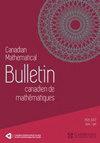Bohr–Rogosinski radius for a certain class of close-to-convex harmonic mappings
IF 0.4
4区 数学
Q3 MATHEMATICS
Canadian Mathematical Bulletin-Bulletin Canadien De Mathematiques
Pub Date : 2023-01-31
DOI:10.4153/s0008439523000115
引用次数: 6
Abstract
Abstract Let $ \mathcal {B} $ be the class of analytic functions $ f $ in the unit disk $ \mathbb {D}=\{z\in \mathbb {C} : |z|<1\} $ such that $ |f(z)|<1 $ for all $ z\in \mathbb {D} $ . If $ f\in \mathcal {B} $ of the form $ f(z)=\sum _{n=0}^{\infty }a_nz^n $ , then $ \sum _{n=0}^{\infty }|a_nz^n|\leq 1 $ for $ |z|=r\leq 1/3 $ and $ 1/3 $ cannot be improved. This inequality is called Bohr inequality and the quantity $ 1/3 $ is called Bohr radius. If $ f\in \mathcal {B} $ of the form $ f(z)=\sum _{n=0}^{\infty }a_nz^n $ , then $ |\sum _{n=0}^{N}a_nz^n|<1\;\; \mbox {for}\;\; |z|<{1}/{2} $ and the radius $ 1/2 $ is the best possible for the class $ \mathcal {B} $ . This inequality is called Bohr–Rogosinski inequality and the corresponding radius is called Bohr–Rogosinski radius. Let $ \mathcal {H} $ be the class of all complex-valued harmonic functions $ f=h+\bar {g} $ defined on the unit disk $ \mathbb {D} $ , where $ h $ and $ g $ are analytic in $ \mathbb {D} $ with the normalization $ h(0)=h^{\prime }(0)-1=0 $ and $ g(0)=0 $ . Let $ \mathcal {H}_0=\{f=h+\bar {g}\in \mathcal {H} : g^{\prime }(0)=0\}. $ For $ \alpha \geq 0 $ and $ 0\leq \beta <1 $ , let $$ \begin{align*} \mathcal{W}^{0}_{\mathcal{H}}(\alpha, \beta)=\{f=h+\overline{g}\in\mathcal{H}_{0} : \mathrm{Re}\left(h^{\prime}(z)+\alpha zh^{\prime\prime}(z)-\beta\right)>|g^{\prime}(z)+\alpha zg^{\prime\prime}(z)|,\;\; z\in\mathbb{D}\} \end{align*} $$ be a class of close-to-convex harmonic mappings in $ \mathbb {D} $ . In this paper, we prove the sharp Bohr–Rogosinski radius for the class $ \mathcal {W}^{0}_{\mathcal {H}}(\alpha , \beta ) $ .一类近凸调和映射的Bohr-Rogosinski半径
摘要设$ \mathcal {B} $为单位圆盘$ \mathbb {D}=\{z\in \mathbb {C} : |z|<1\} $上的解析函数$ f $的类,使得$ |f(z)|<1 $对所有$ z\in \mathbb {D} $。如果$ f(z)=\sum _{n=0}^{\infty }a_nz^n $的形式为$ f\in \mathcal {B} $,那么$ |z|=r\leq 1/3 $和$ 1/3 $的形式为$ \sum _{n=0}^{\infty }|a_nz^n|\leq 1 $就不能改进。这个不等式叫做玻尔不等式这个量$ 1/3 $叫做玻尔半径。如果$ f\in \mathcal {B} $的形式是$ f(z)=\sum _{n=0}^{\infty }a_nz^n $,那么$ |\sum _{n=0}^{N}a_nz^n|<1\;\; \mbox {for}\;\; |z|<{1}/{2} $和半径$ 1/2 $是类$ \mathcal {B} $的最佳选择。这个不等式叫做玻尔-罗戈辛斯基不等式对应的半径叫做玻尔-罗戈辛斯基半径。设$ \mathcal {H} $为定义在单位盘$ \mathbb {D} $上的所有复值调和函数$ f=h+\bar {g} $的类,其中$ h $和$ g $在$ \mathbb {D} $中解析,归一化为$ h(0)=h^{\prime }(0)-1=0 $和$ g(0)=0 $。设$ \mathcal {H}_0=\{f=h+\bar {g}\in \mathcal {H} : g^{\prime }(0)=0\}. $对于$ \alpha \geq 0 $和$ 0\leq \beta <1 $,设$$ \begin{align*} \mathcal{W}^{0}_{\mathcal{H}}(\alpha, \beta)=\{f=h+\overline{g}\in\mathcal{H}_{0} : \mathrm{Re}\left(h^{\prime}(z)+\alpha zh^{\prime\prime}(z)-\beta\right)>|g^{\prime}(z)+\alpha zg^{\prime\prime}(z)|,\;\; z\in\mathbb{D}\} \end{align*} $$是$ \mathbb {D} $中的一类近凸调和映射。本文证明了该类$ \mathcal {W}^{0}_{\mathcal {H}}(\alpha , \beta ) $的尖锐Bohr-Rogosinski半径。
本文章由计算机程序翻译,如有差异,请以英文原文为准。
求助全文
约1分钟内获得全文
求助全文
来源期刊
CiteScore
1.30
自引率
0.00%
发文量
68
审稿时长
24 months
期刊介绍:
The Canadian Mathematical Bulletin was established in 1958 to publish original, high-quality research papers in all branches of mathematics and to accommodate the growing demand for shorter research papers. The Bulletin is a companion publication to the Canadian Journal of Mathematics that publishes longer papers. New research papers are published continuously online and collated into print issues four times each year.
To be submitted to the Bulletin, papers should be at most 18 pages long and may be written in English or in French. Longer papers should be submitted to the Canadian Journal of Mathematics.
Fondé en 1958, le Bulletin canadien de mathématiques (BCM) publie des articles d’avant-garde et de grande qualité dans toutes les branches des mathématiques, de même que pour répondre à la demande croissante d’articles scientifiques plus brefs. Le BCM se veut une publication complémentaire au Journal canadien de mathématiques, qui publie de longs articles. En ligne, il propose constamment de nouveaux articles de recherche, puis les réunit dans des numéros imprimés quatre fois par année.
Les textes présentés au BCM doivent compter au plus 18 pages et être rédigés en anglais ou en français. C’est le Journal canadien de mathématiques qui reçoit les articles plus longs.

 求助内容:
求助内容: 应助结果提醒方式:
应助结果提醒方式:


